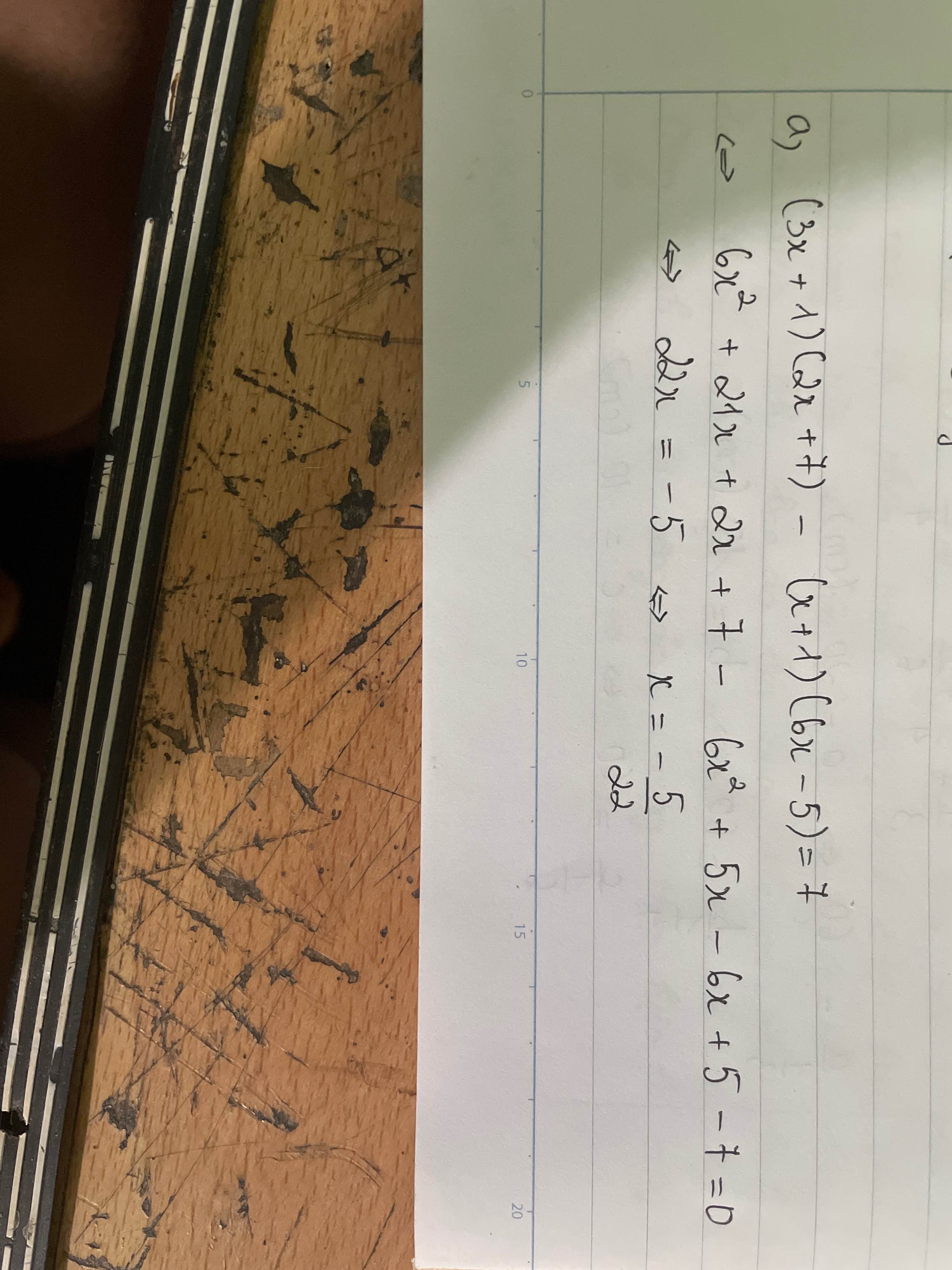(2x-1)^3-8x+4=0
Giúp mình nhanh với ạ!
Hãy nhập câu hỏi của bạn vào đây, nếu là tài khoản VIP, bạn sẽ được ưu tiên trả lời.


2x³ - 8x = 0
2x(x² - 4) = 0
2x = 0 hoặc x² - 4 = 0
*) 2x = 0
x = 0
*) x² - 4 = 0
x² = 4
x = 2 hoặc x = -2
Vậy x = 0; x = -2; x = 2

a, \(2x\left(x-3\right)-15+5x=0\\ \Rightarrow2x\left(x-3\right)-\left(15-5x\right)=0\\ \Rightarrow2x\left(x-3\right)-5\left(3-x\right)=0\\ \Rightarrow\left(2x+5\right)\left(x-3\right)=0\\ \Rightarrow\left[{}\begin{matrix}x=-\dfrac{5}{2}\\x=3\end{matrix}\right.\)
b, \(x^3-7x=0\\ \Rightarrow x\left(x^2-7\right)=0\\ \Rightarrow\left[{}\begin{matrix}x=0\\x=\pm7\end{matrix}\right.\)
c, \(\left(2x-3\right)^2-\left(x+5\right)^2=0\\ \Rightarrow\left(2x-3-x-5\right)\left(2x-3+x+5\right)=0\\ \Rightarrow\left(x-8\right)\left(3x+2\right)=0\\ \Rightarrow\left[{}\begin{matrix}x=8\\x=-\dfrac{2}{3}\end{matrix}\right.\)
Xem lại đề câu d

a) Ta có: \(\left(x-3\right)=\left(3-x\right)^2\)
\(\Leftrightarrow\left(x-3\right)^2-\left(x-3\right)=0\)
\(\Leftrightarrow\left(x-3\right)\left(x-4\right)=0\)
\(\Leftrightarrow\left[{}\begin{matrix}x=3\\x=4\end{matrix}\right.\)
b) Ta có: \(x^3+\dfrac{3}{2}x^2+\dfrac{3}{4}x+\dfrac{1}{8}=\dfrac{1}{64}\)
\(\Leftrightarrow x^3+3\cdot x^2\cdot\dfrac{1}{2}+3\cdot x\cdot\dfrac{1}{4}+\left(\dfrac{1}{2}\right)^3=\dfrac{1}{64}\)
\(\Leftrightarrow\left(x+\dfrac{1}{2}\right)^3=\left(\dfrac{1}{4}\right)^3\)
\(\Leftrightarrow x+\dfrac{1}{2}=\dfrac{1}{4}\)
hay \(x=-\dfrac{1}{4}\)
c) Ta có: \(8x^3-50x=0\)
\(\Leftrightarrow2x\left(4x^2-25\right)=0\)
\(\Leftrightarrow x\left(2x-5\right)\left(2x+5\right)=0\)
\(\Leftrightarrow\left[{}\begin{matrix}x=0\\x=\dfrac{5}{2}\\x=-\dfrac{5}{2}\end{matrix}\right.\)
e) Ta có: \(x\left(x+3\right)-x^2-3x=0\)
\(\Leftrightarrow\left(x+3\right)\left(x-1\right)=0\)
\(\Leftrightarrow\left[{}\begin{matrix}x=-3\\x=1\end{matrix}\right.\)
f) Ta có: \(x^3+27+\left(x+3\right)\left(x-9\right)=0\)
\(\Leftrightarrow\left(x+3\right)\left(x^2-3x+9\right)+\left(x+3\right)\left(x-9\right)=0\)
\(\Leftrightarrow\left(x+3\right)\left(x^2-2x\right)=0\)
\(\Leftrightarrow x\left(x-2\right)\left(x+3\right)=0\)
\(\Leftrightarrow\left[{}\begin{matrix}x=0\\x=2\\x=-3\end{matrix}\right.\)

\(A=x^3-2x+n\)
\(B=n-2\)
\(A\text{⋮}B\) ⇒ \(\left(x^3-2x+n\right)\text{⋮}\left(n-2\right)\)
⇒ \(\left[\left(x^3-2x^2\right)+\left(2x^2-4x\right)+\left(2x-4\right)+\left(n+4\right)\right]\text{⋮}\left(n-2\right)\)
⇒ \(\left[x^2\left(x-2\right)+2x\left(x-2\right)+2\left(x-2\right)+\left(n+4\right)\right]\text{⋮}\left(n-2\right)\)
⇒ \(\left[\left(x-2\right)\left(x^2+2x+2\right)+\left(n+4\right)\right]\text{⋮}\left(x-2\right)\)
Vì \(\left(x-2\right)\left(x^2+2x+2\right)\text{⋮}\left(n-2\right)\)
Để \(A\text{⋮}B\)
⇒ \(n+4=0\)
⇒ \(n=-4\)

\(a)\left(x-2\right)\left(x^2+2x-3\right)\ge0.\)
Đặt \(f\left(x\right)=\left(x-2\right)\left(x^2+2x-3\right).\)
Ta có: \(x-2=0.\Leftrightarrow x=2.\\ x^2+2x-3=0.\Leftrightarrow\left[{}\begin{matrix}x=1.\\x=-3.\end{matrix}\right.\)
Bảng xét dấu:
x \(-\infty\) -3 1 2 \(+\infty\)
\(x-2\) - | - | - 0 +
\(x^2+2x-3\) + 0 - 0 + | +
\(f\left(x\right)\) - 0 + 0 - 0 +
Vậy \(f\left(x\right)\ge0.\Leftrightarrow x\in\left[-3;1\right]\cup[2;+\infty).\)
\(b)\dfrac{x^2-9}{-x+5}< 0.\)
Đặt \(g\left(x\right)=\dfrac{x^2-9}{-x+5}.\)
Ta có: \(x^2-9=0.\Leftrightarrow\left[{}\begin{matrix}x=3.\\x=-3.\end{matrix}\right.\)
\(-x+5=0.\Leftrightarrow x=5.\)
Bảng xét dấu:
x \(-\infty\) -3 3 5 \(+\infty\)
\(x^2-9\) + 0 - 0 + | +
\(-x+5\) + | + | + 0 -
\(g\left(x\right)\) + 0 - 0 + || -
Vậy \(g\left(x\right)< 0.\Leftrightarrow x\in\left(-3;3\right)\cup\left(5;+\infty\right).\)

1: Ta có: \(\left(3-x\right)^2+\left(2x+1\right)^2-\left(2-x\right)^2-\left(2x+1\right)^2=0\)
\(\Leftrightarrow\left(x-3\right)^2-\left(x-2\right)^2=0\)
\(\Leftrightarrow\left(x-3+x-2\right)=0\)
\(\Leftrightarrow x=\dfrac{5}{2}\)
2: Ta có: \(\left(1-2x\right)^2-3\left(x-1\right)^2+\left(x+1\right)^2-\left(x-1\right)^2-\left(x-1\right)^2=0\)
\(\Leftrightarrow4x^2-4x+1-3x^2+6x-3+\left(x+1\right)^2-2\left(x-1\right)^2=0\)
\(\Leftrightarrow x^2+2x-2+x^2+2x+1-2\left(x^2-2x+1\right)=0\)
\(\Leftrightarrow2x^2+4x+1-2x^2+4x-2=0\)
\(\Leftrightarrow x=\dfrac{1}{8}\)



(2x - 1)³ - 8x + 4 = 0
(2x - 1)³ - 4x(2x - 1) = 0
(2x - 1)[(2x - 1)² - 4x] = 0
(2x - 1)[(2x - 1)(2x - 1) - 4x] = 0
(2x - 1)[2x(2x - 1) - 1.(2x - 1) - 4x] = 0
(2x - 1)(4x² - 2x - 2x + 1 - 4x) = 0
(2x - 1)(4x² + 1) = 0
⇒ 2x - 1 = 0 hoặc 4x² + 1 = 0
*) 2x - 1 = 0
2x = 1
x = 1/2
*) 4x² + 1 = 0
4x² = -1 (vô lý vì 4x² ≥ 0 với mọi x)
Vậy x = 1/2
(2x - 1)(4x² - 2x - 2x + 1 - 4x) = 0
(2x - 1)(4x² + 1) = 0
có j đó sai sai